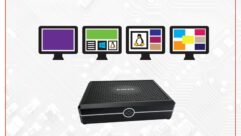

It’s Just a Box
Long live the lowly overhead projector. Schools still use it today because, well, it gets the job done. What does that tell us about more modern AV equipment?
Back in october, infocomm’s professional Education and Training Committee met in Fairfax, Va., to review and select course proposals for InfoComm 2011 in Orlando, Fla. That process, which I’ve been a part of for almost a decade, has now been pretty much refined to a science. During course selection, the committee tries to fill holes in the InfoComm curriculum where a new technology or AV design process might need teaching. Such topics range from new display technologies to control systems, from applications software to the use of smart phones for controlling AV equipment or giving presentations.
The night after our preliminary vetting session, I was getting ready to hit the sack when a story on the local Fox TV news station caught my attention. It was about a Washington, D.C., inner-city charter school and a dynamic young teacher named Julia King, who was not only getting her elementary school students more involved in learning, but was also teaching them manners, respect for others, and the discipline to stick with class assignments.
None of this is earth-shattering stuff; we run across stories like King’s every day. And with the recent release of the documentary Waiting for Superman, there’s probably more attention focused on K–12 education in the United States than ever before. However, as this particular news story unfolded, something odd caught my eye. I saw kids sharply dressed in clean uniforms vigorously engaged in discussions about everything from math to history. There was clearly a true spirit of cooperation between teacher and students, illustrated by cutaway shots of the classroom, blackboards festooned with notes, and the sole piece of AV equipment in the entire rooman overhead transparency projector.
You heard me right. I did a double take when I spotted that relic of the 20th century. The transparency projector is a product that’s been both a staple of classrooms and the butt of industry jokes. Yet there it was, used by an enthusiastic teacher who looked like a member of Generation Y, a group that grew up hardwired to the Internet and fluent in a wide variety of handheld electronic gadgets. Where were all of the latest AV teaching tools? The cutting-edge stuff? Where was the distance-learning station, the interactive whiteboard, the Web-enabled wireless projector? Heck, where were the computers?
Perhaps the teacher was technophobic, but that doesn’t seem likely. Maybe she’s part of a “back-to-teaching-basics” movement. Maybe funding for technology was an issue, though it appeared to be a relatively new charter school.
Whatever the case, there was the projector—front and center—projecting notes from a transparency onto a plain-looking blackboard (or more accurately, greenboard) that already had chalk notations scribbled all over it.
Solid Fundamentals
You’re probably wondering where I’m going with this story. Well, if there is a point to be made, it’s that we, as members of a high-tech industry, sometimes get too caught up in the promise of new technology and don’t question its viability or practicality nearly enough. King seized the day, so to speak, by jumping in and concentrating on solid teaching fundamentals, none of which really require anything more than a blackboard and an overhead projector. And her students didn’t lack for enthusiasm and demonstrated skills.
I’ve been involved with the AV industry since 1978 and I’ve seen plenty of can’t-miss technologies come and go. Remember Video Show? The Voyager dual-lens 35-mm slide projector with built-in dissolve? LCD panels for overhead projectors? Web TV? The mini CD format? Video streaming and so-called “multimedia,” circa 1998? All of them came in with a splash and then flamed out for any number of reasons, among them questionable practicality and viability. (And some, such as streaming, were reborn years later when enabling technology caught up to their promise.)
As we turn the corner into the next decade, we can all stand to use more perspective when we’re advocating for and adopting new AV technologies, especially for classrooms. Yes, a lot of the stuff Pro AV will write about in 2011 is way cool, and manufacturers will be betting the farm that it will catch on. Just don’t forget that, as always, and for reasons we don’t necessarily recognize at the time, there will be winners and losers.
Trends will spring up and die off. Pundits will attempt to forecast which way the winds will blow, and influential voices will call for more technology funding and “smart classrooms” in an attempt to close this-or-that perceived gap in education and technological literacy.
If you want your customers to buy into a new technology or piece of hardware, first play devil’s advocate by asking yourself three questions: Does this new technology allow me to do something I couldn’t do before (or could accomplish only with a great deal of effort)? Are the functions and operations of this technology largely transparent and intuitive, compared to previous iterations? Are there demonstrated and verifiable cost or time savings to using this technology?
And be honest! If you can’t answer “yes” to all three questions, then you may not be not working in your client’s best interest. The overhead projector has survived so long because it is highly effective as a teaching aid, it’s intuitive and transparent in operation, and it’s inexpensive to purchase and maintain. Is it old school? Absolutely.
Going forward, don’t get caught up in acronyms, standards, buzzwords, and hype. Don’t obsess over which wireless protocol, display technology, or control interface a new product uses. (Or even, for that matter, how “green” the product is.)
Instead, think long and hard about these three questions while you peruse six-color sell sheets and cruise the aisles at trade shows.
After all, it’s just a box.
Pete Putman is Pro AV’s senior contributing editor and former InfoComm Educator of the year. His new Pro AV e-newsletter, Wake-Up Call, covers all things digital video.










